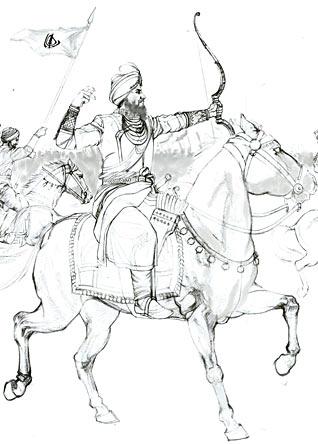History
Photo Exhibit - Hola Mohalla
TO VIEW PHOTO EXHIBIT, PLEASE GO TO THE END OF THE ARTICLE BELOW, AND CLICK ON "START THE SHOW".
Holgarh is one of the many historical forts at Anandpur Sahib, picturesquely located in the foothills of the Shivalik ranges in the Ropar district of Punjab, about 85 km northwest of Chandigarh.
It was there that on the first day of Chet (a month on the lunar calendar used widely in India) in 1701 AD that Guru Gobind Singh presided over a gathering of Sikhs and declared that henceforth the Hola Mohalla (sometimes spelt Mahalla) would be celebrated by the Sikhs as a day of fun and games.
This was a new tradition, one in which there would be two groups of Sikhs acting as opposing parties in a mock battle. The winners would be given blessings by the Guru himself, who would also oversee the exercises and festivities.
As Bhai Kahan Singh tells us in the monumental work, Mahan Kosh, the first Sikh encyclopedia, Hola is derived from the word halla (a military charge) and the term mohalla stands for an organized procession or an army column. The words "Hola Mohalla" would thus stand for "the charge of an army".
Even today, the Nihangs (ascetic warriors) continue to maintain the traditions of yore. They practice horsemanship, and are skilled at tent-pegging, gatka (Sikh martial arts), jousting and other war-like sports.
They cut a fine figure dressed in deep blue traditional robes, often contrasted with saffron sashes or turbans. They wear large, peaked turbans, often embellished with quoits, malas and Sikh emblems. They also sport a variety of traditional arms, ranging from swords, daggers and spears to firearms such as rifles, shotguns, and pistols.
Their processional columns start from their camps - called chhawni (literally, military cantonment) - and gradually wind their way down to Anandpur Sahib. The Nihangs flaunt their martial traditions as they swagger through the lush countryside, and are feted by the villagers en route and as they finally arrive at their destination.
Hola Mohalla is recognized as a National Festival by the Government of India. When crowds gather, politicians can't be far behind. Consequently, many political rallies are also held here during the three days of festivities. Nevertheless, the general atmosphere retains an air of festive piety.
Langars, or voluntary community kitchens, are aplenty and every pilgrim is expected to partake of the food while sitting in pangats, or neat rows of people sitting down together on the ground to eat.
Several hundred thousand people are expected to gather during the Hola Mohalla this year, in the first week of March.
Paintings: Top - Detail from painting, Akali Nihang Singh, by Kanwar Singh Dhillon
Bottom - Detail from sketch, Anandpur, by Kanwar Singh Dhillon
March 9, 2009
[This article first appeared in these pages on March 2, 2007.]
Conversation about this article
1: Aalem Singh (Detroit, USA), March 04, 2007, 2:03 PM.
I thought this article was really interesting because I have never heard of the Hola Mohalla before. I would now like to attend it one day.
2: Kanwal Jit Singh Bakshi (Auckland, New Zealand), March 05, 2007, 12:12 PM.
Having never heard about the history of the Hola Mohalla before, I asked the granthi at our Gurudwara ... but he too didn't know much about it. Thanks for this information and keep it up.
3: Deepak Singh (India), March 10, 2007, 3:09 AM.
This festival is doubly important for us because it is based on the "reet" established by Guru Gobind Singh. It is another symbol of the love of freedom and independence in-built in our community, captured in spirit in the very art of the "Gatka". This festival is more than just entertainment for us ... it should be instituted in some form or the other around the world in the diaspora's scattered communities.
4: Gurpartap Singh (Chandigarh, Punjab, India), July 22, 2007, 2:43 AM.
This annual festival held at Anandpur Sahib in Punjab and now replicated at other Gurdwaras worldwide was started by the tenth Sikh Guru, as a gathering of Sikhs for military exercises and mock battles on the day following the festival of Holi at Anandpur Sahib. It reminds the people of valour and defence preparedness, concepts dear to the Tenth Guru who was at that time battling the Mughal empire and the hill kings.
5: H.Singh (Los Angeles, U.S.A.), March 10, 2009, 9:09 PM.
What's the story behind about colouring people on this day?
6: Manjyot Kaur (New York City, U.S.A.), March 11, 2009, 8:13 PM.
Beautiful images, but #5 strikes me as quite intrusive. It definitely looks to me like this photo was taken during one of the most crucial moments of an Amrit Sanchaar. The presence of an outside photographer at this ceremony seems very inappropriate, as well as against the Rehat Maryada.
7: Prabhdeep Ghuman (New Zealand), June 16, 2009, 4:08 AM.
Excellent information on Hola!
8: Rajkamal singh (Delhi, India), July 09, 2011, 8:31 AM.
Awesome pictures. I have earlier heard about Hola Mohalla from many people. But never understood exactly what importance or significance it had in a Sikh's life ... until I read this article. I have decided I'll definitely join Hola Mohalla next year in Anandpur Sahib.




